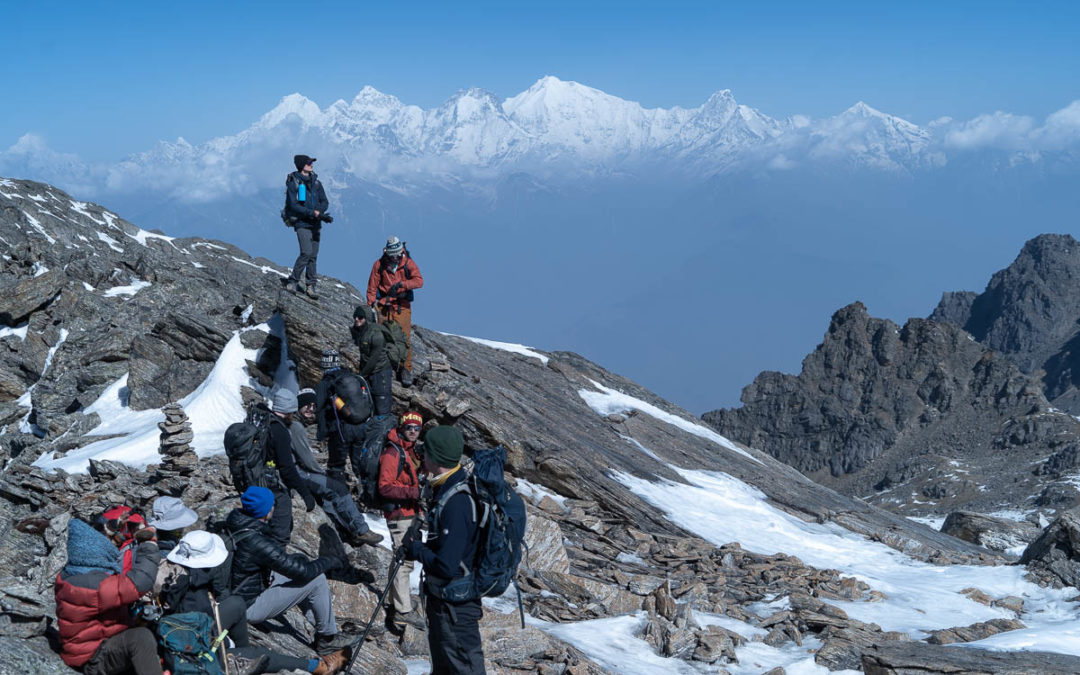We have been quiet of late as we have been busy running, wrapping up and decompressing from the 12-week Adventure Guide Programme we ran on behalf of our partner, Pure Exploration, New Zealand.
When the students arrived at the beginning of March, Covid cases were low and the country was open for business, however, from the very beginning we created a tight group bubble and followed the government rules on quarantine, PCR tests etc. to a T.
It was big decision to accept a group during the ongoing pandemic, one that wasn’t taken lightly by both our partner and ourselves. Thankfully by following our own super strict protocols, limiting the exposure of the students, our instructor team and any communities they came in contact with, we were able to run a successful programme, keeping everyone safe and Covid free.
The only hotel time for the group was in Kathmandu, initially for their arrival quarantine, then short visits between sections of the programme, and of course, again at the end. For the rest of the programme they camped, enabling us to maintain the tight bubble we had established from the beginning. All in all they spent 60 nights under canvas, cooking for themselves and with very rudimentary facilities for everything else. We established two basecamps for the different phases of the programme, one in Hattiban to the south of Kathmandu and the other in Thumka, near Bandipur. By doing this we not only limited the group’s travel miles, but also unnecessary interaction with potentially vulnerable communities.
As cases began to sore mid to late April, we were grateful the group was away in the middle of nowhere, self-contained and enjoying the fresh air and open spaces of rural Nepal, away from the Covid hotspots. Things only began to get tricky logistically when it was declared that the Kathmandu Valley would be going into lockdown as of the 29th April, and many other restrictions were applied locally across the different districts of Nepal. The team was due to leave in early May to do the Annapurna Circuit as a self-supporting camping trek, but unfortunately the worry of community transmission and local restrictions put paid to that idea. Instead, the group remained where they were in Thumka, making the most of the time to further hone their newly learned climbing skills and the opportunity to explore the local cave system. Although disappointed at the cancellation of the trek, all things considered, things could’ve been a lot worse.
The next bombshell to hit was the closure of the international airport, initially for a week, but this was extended just before the original deadline, as the virus took hold and cases began to rise exponentially. Prior to the extension notice, plans were made to bring the group back to Kathmandu in readiness for them to be able to return home as soon as the airport reopened. Of course, the extension notice was posted as the group was on the road back to Kathmandu, after receiving the necessary permissions to travel, which had taken two full days to obtain. Although mildly irritating, it did however give the group the opportunity to quarantine once more as a bubble in Kathmandu, as per the new government regulations, while organizing their flights home on the few charter flights that were given permission to fly during this time. Thankfully the American contingent were able to leave on one of the first flights out of the country, while it took a further week for the Europeans and Canadians to secure their flights, leaving just one working on getting back to Australia.
In the end the programme was cut short by just two weeks and what was lost in the cancelled second trek, was gained in extra climbing hours. Each hurdle along the way, from the evacuation from the forest fire in Hattiban, to when to call it day on the programme, to working with the necessary government agencies for permits and every other hurdle thrown our way, were all teachable moments and provided valuable lessons and experience for the students on this course. Most importantly however, everyone remained safe and Covid free throughout the programme, and the fact that we were able to give our team some much needed work after a year of nothing, and the opportunity to practice old and learn new skills was an added bonus.
If you are interested in reading about the programme from one of the student’s perspective, you can read them here, on our HQ Diaries.
At the time of writing, cases appear to be dropping in the urban areas, especially the Kathmandu Valley, but the worry is that it is now taking hold in the rural areas, where there is little to no specialist care available. Vaccines are slowly arriving from one donor or other so second doses can be given and the rollout that started so promisingly back in January can continue in a limited capacity. With the supply line from India still closed, and the government struggling to find a supplier who is willing to sell suitable vaccines at market price, we are now reliant on the generosity of the wealthy nations to share their excess supply, before our health system completely implodes and a potential 3rd wave hits.
What the next few months will bring, we can only wait and see. Whether there will be an autumn season or not, it is still too early to predict. We will of course keep you posted. In the meantime, we shall continue to hunker down in the hope that this latest wave shall pass us by unnoticed.
Thank you to all those who have reached out to us as the crisis here in Nepal hit the international news. Your thoughts and prayers are deeply appreciated, and as with all storms, this too shall pass or at least lessen to something less scary and dangerous.


Recent Comments